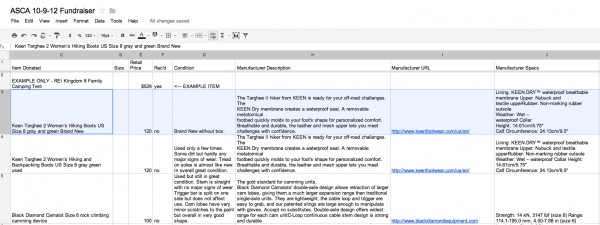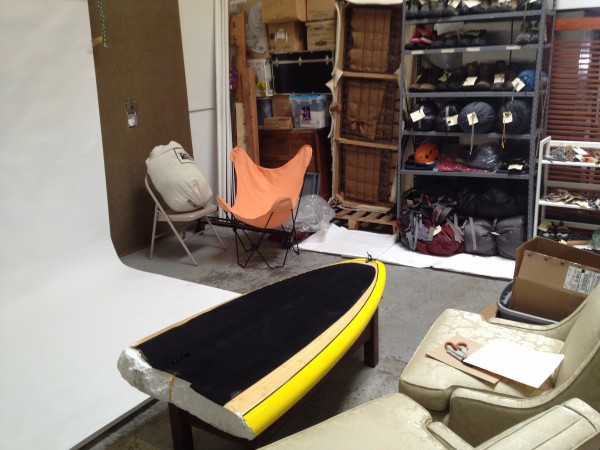To date we have raised $100,000+, thanks in large part for you guys and matching from Planet Granite Gives Back.
It is now our goal to help other non-profits and causes run their own online auctions. We all have a lot of stuff we have not used anymore. If there is a way to collect that stuff, organize volunteers and run a successful auction, all that unused stuff turns into a lot of money for your cause.
This article is a free and continuously updated attempt to make the whole process as painless and effective as possible.
Now this isn't an entirely new idea. There are organizations that offer auction services for non-profits. But from my research, those organizations generally have three drawbacks:
- miss out on engaging as much with their members
- members miss out on the tax benefits of donating gear to charity
- everyone misses the environmental benefit of taking stuff that probably isn't being used and putting it back into use: i.e. They miss the chance to promote the "Re-Use Economy".
In summary
The goal is that this "SuperTopo Guide To Online Auctions For Causes" will help many non-profits of all types take unused stuff from their supporters, promote the re-use economy, and raise money for their missions.
SuperTopo Guide To Online Auctions
Step 1 - Get get rid of your crap: be honest, if you have not used it in a year, do you really need it?
Make a list of all the spaces you want to scour: garage, basement, storage locker etc. Prioritize each area in order of most likely to yield good stuff.
IMPORTANT: Remove the all the stuff into an open area. It is essential to get everything out. Yes, every last thing. If you don't you will hold onto stuff you don't use.
Make four piles:
1 Trash
2 Recycling
3 Stuff you have used in the last year and want to keep.
4 Stuff you have not used in the last year.
Pile 4 now gets divided up.
- Stuff you are ready to get rid of and can likely be sold for more than $X0.00* and easily fits in a box**. This stuff goes to your auction)
- Stuff you are ready to get rid of and can likely be sold for less than $X0.00* This stuff gets donated to Goodwill, cancer society, etc
* The amount is subject. For some people/non-profits, $X0.00 is $50 which means that if it is worth less than $50, it is just not worth the hassle to deal with. For other people, $25 is the amount.
** If it does not easily fit in a box 24 x 24 x 24 or smaller, it will likely be a pain to sell online. Shipping will be expensive and cumbersome. You can either sell things on eBay with a "local pick up only" option or sell on craigslist or just give the item away unless it has a lot of value.
How do you find out the eBay/auction value of something? Go to http://ebay.com and enter your item name into the search box. Next, scroll down the left column, to "Show Only" and check the box "Completed listings." The numbers with green results actually sold (red prices did not sell because they were likely over priced).
Step 2 Get donations from the community
Send out emails to anyone that has items to auction off. Look for items worth well more than *$X0.00 that can be easily shipped. The bigger ticket the item the better. Unique experiences (climbing El Capitan with a superstar) or vacation rentals can often raise $500-1,000.
Step 3 Run The Ebay Auction
There are many great books that go into this in much more detail and here is a great podcast. Below is just a cheat sheet of the most simple way I have found. If you have suggestions on how to make this process more efficient, please email me or post below.
A) Get an ebay User id. If you are doing a big auction, you want to make sure your user ID has some feedback. More positive feedback = more confidence from buyers. How do you get feedback? Tip Start by selling your least expensive things first. For some odd reason, eBay gives your feedback score the same weight whether you sell $2 t-shirts of $20,000 cars. Alternatively, you can buy a bunch of inexpensive things on eBay to raise your feedback score.
B) Have the non-profit get a PayPal account. Go through all the steps to get as verified as possible. This way, at the end of the auction, all the money goes directly to the non-profit and does not need to be transferred around (which can incur transaction costs and is less trusted than paying directly to a non-profit).
C) Create a spreadsheet with all the item details. Google Drive (formerly Google Docs) is a great way to create a document everyone can easily share and update. Here is a sample spreadsheet for the October 9 Tommy Caldwell Auction
D) Get the free eBay App for iPhone, Android, iPad etc. We just recently started using this and its a game changer. The most annoying part of the eBay listing process is managing photo uploads and the eBay app massively streamlines this process. Fast is key because the longer this process takes, the less likely you are to actually do it.
There are two ways to use the app:
E) Taking photos. Get a big white background: a white bed sheet gets you 80% of the way there or go pro and get a big white seamless background. Take photos in a place with lots of natural light (but no direct sunlight). The shaded side of a building or under a frosted skylight is ideal. I have spent sooooo much time trying to make products look great using artificial light using studio lighting kits like this. It is really hard to consistently get good colors and no shadows. Don't bother. Use natural light.
F) Figure out shipping. This is the crux and the reason so many people avoid online auctions. I generally ship USPS for items less than 5 pounds and FedEx UPS for items 5Lb+. I charge exactly what it costs me as nobody likes getting gouged for shipping. But many eBay experts feel you have the right to charge a few extra dollars for your handling time. I have this 50lb scale.
I really encourage adding international shipping to items that costs $20 or less to ship internationally. The downside is that only economical way to ship is USPS and their international tracking is lacking or nonexistent. So eventually something will get lost or the buyer will just claim it is lost and hope you refund them. This is a pain and will cost you money. HOWEVER, when you average this out over many auctions, you come out way ahead by opening your auctions to international buyers.
2 Recommended Shipping Options
1 - PayPal's shipping option makes it very easy to ship with USPS or UPS and track (no FedEx). As soon as someone pays, you just go into PayPal and click on the button to ship. You then get walked through the process.
2 - Endicia For Mac. I use Endicia because it is faster: you just cut and paste the address and hit print. But if you are not shipping a lot, by far the easiest option is to use PayPal. Endicia is also the fastest way I have found to calculate shipping for listing items. Using calculators and online shipping on USPS.com adds in a lot of steps... and its all about efficiency in this game!
G) Starting Time. The short answer: Sunday-Thursday between 6-8 PM. The real answer is that it depends on what you are selling. The only way to find the best time is to sell a lot of the same stuff at different times and collect data.
H) Starting Price. I generally list things for the absolute smallest amount I would accept for an item and still by happy. A more scientific and time-consuming but profitable way is to research what your item has been selling for recently (see how to search completed listings above), find the average, and list it a little below the average if you want your item to sell on the first go. List it above the average if you are willing to relist your auction again and again if it does not sell (and willing to pay some extra feeds to do so).
Step 4 Promote the auction
The beauty of a place like eBay, is that a major audience/market exists already. So this is not the most important place to put time (much better to double down on time spent finding items to auction). That said, never hurts to post all over forums, Facebook, Twitter, blogs, etc
Step 5
Collect the money with PayPal.
Step 6
Ship the items and get the money to the causes. Shipping is a big pain for most people. If you live near San Rafael, California, I will gladly donate boxes and packing materials to any only auctions for non-profits. Otherwise, you will need to collect boxes or buy them. If you are going to buy boxes, the best deal I found is Uline.com
Spread the word about this process. Tell other causes and non profits how they can raise money for their mission.

